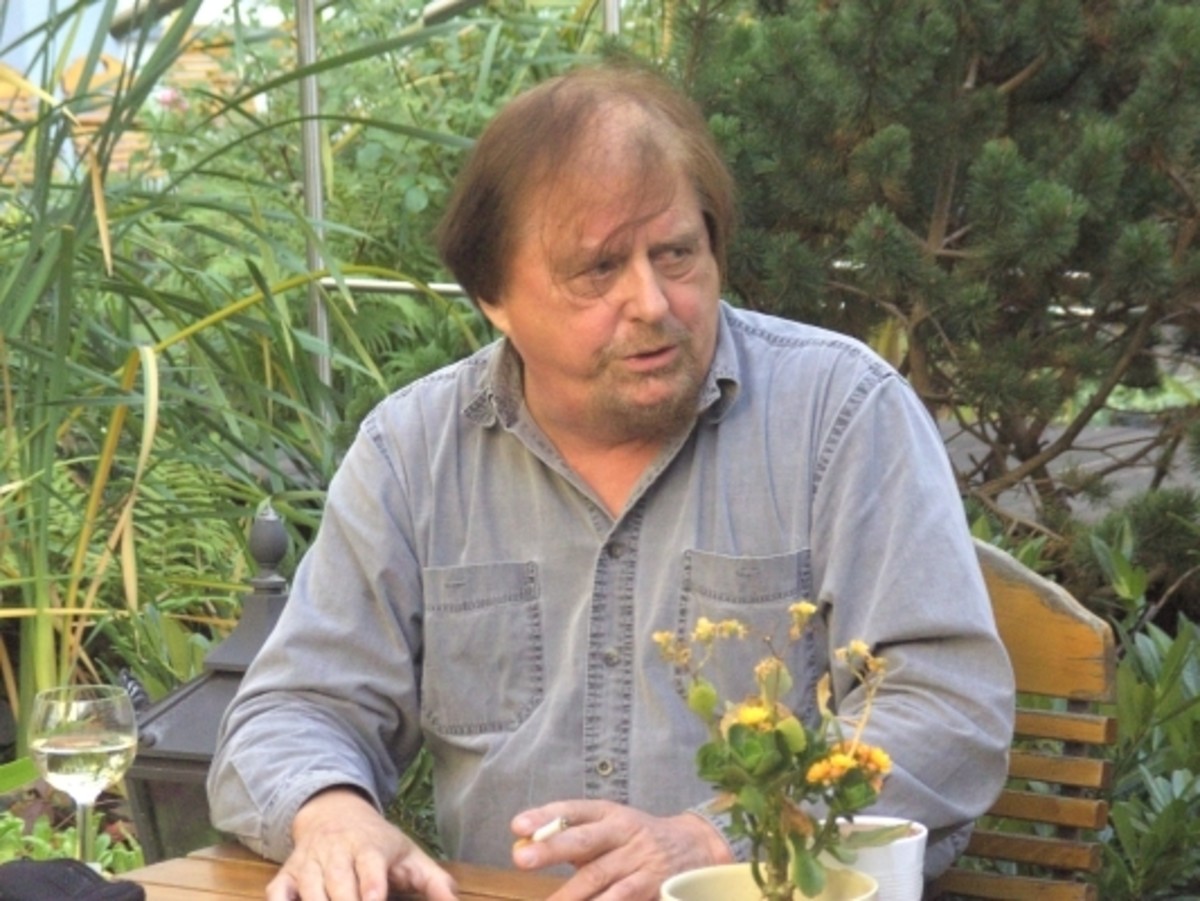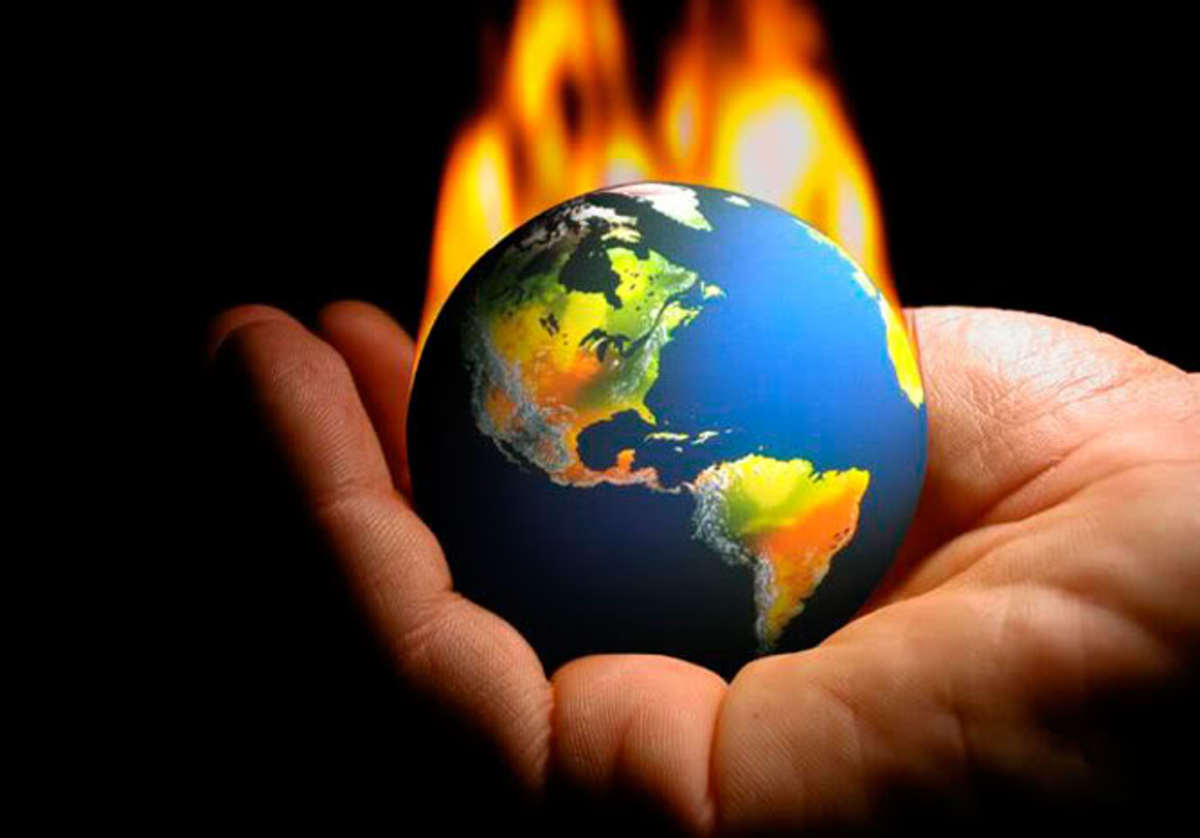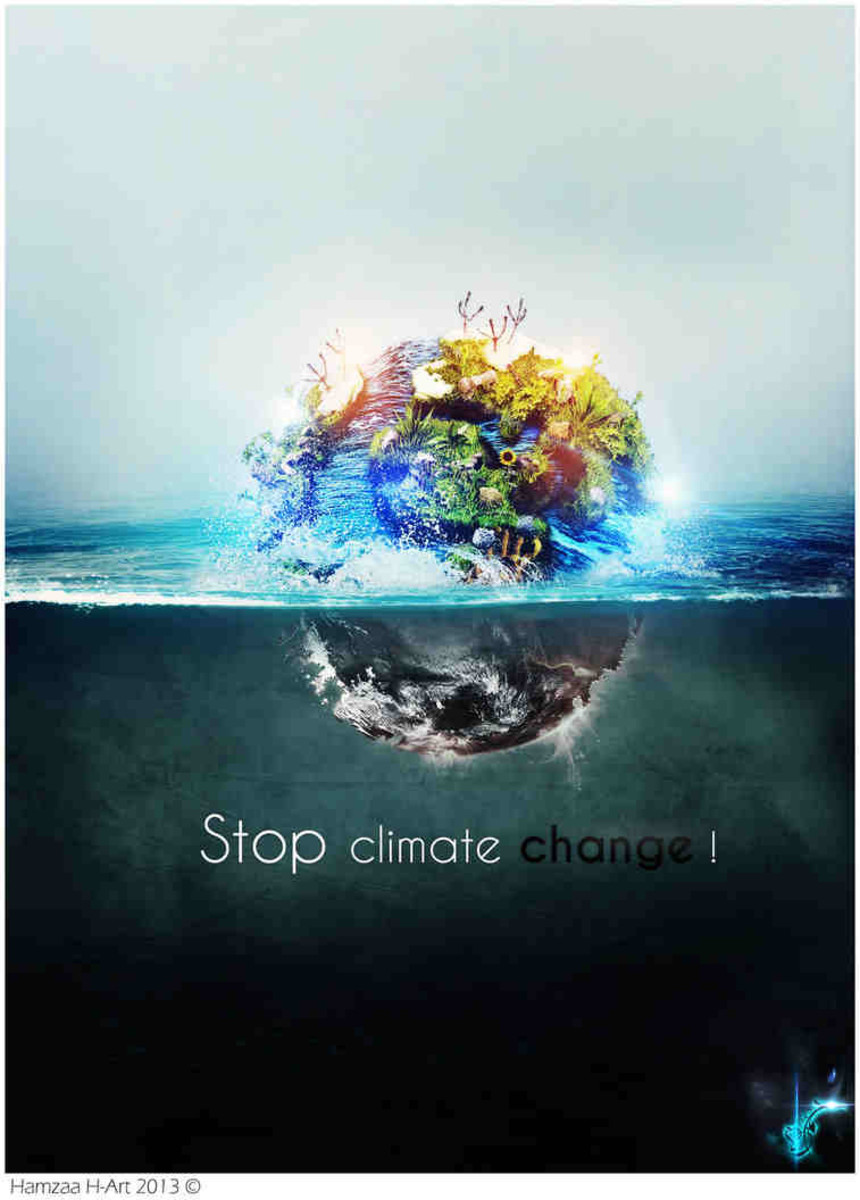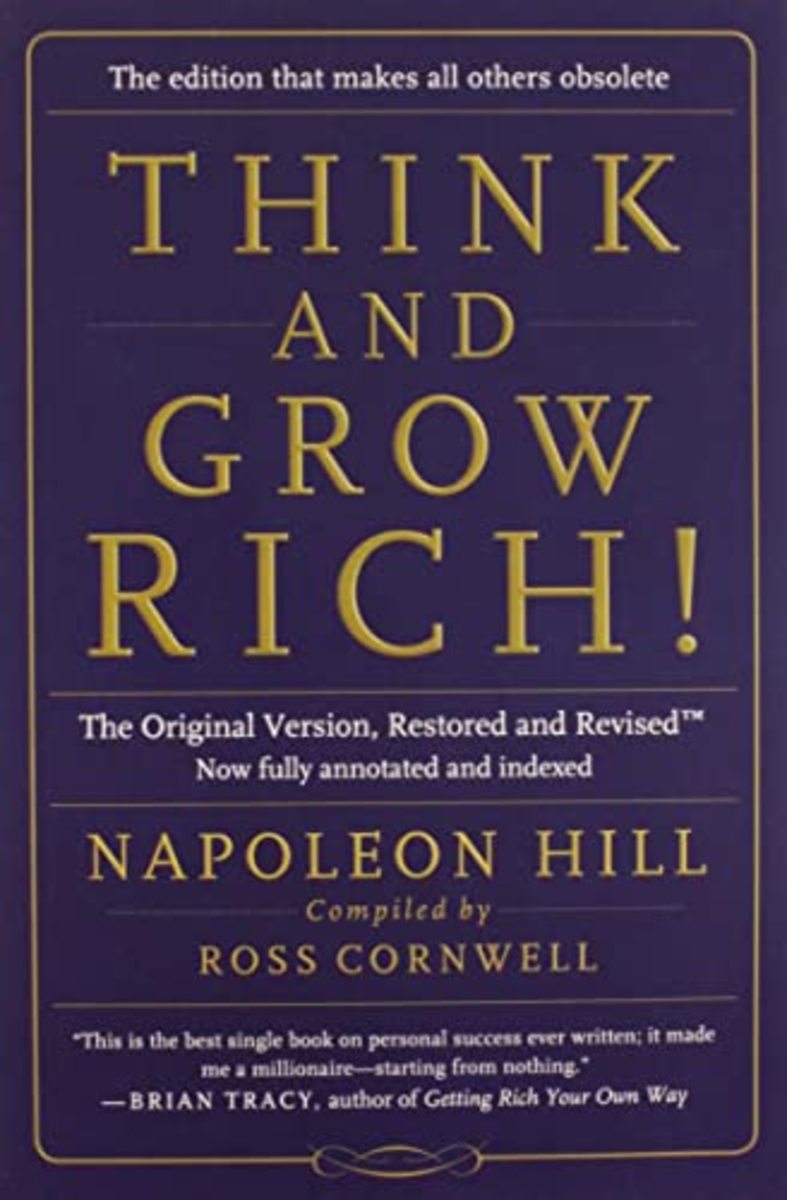Michael Mann's "The Hockey Stick And The Climate Wars": A Summary Review
"The Hockey Stick And The Climate Wars," by Michael Mann. Columbia University Press, 2012. Reviewed July, 2012.
Dr. Michael E. Mann’s memoir of science, politics and change, The Hockey Stick And The Climate Wars: Dispatches From The Front Lines, probably won’t change many minds. That’s a shame; it should. It’s easy to read, highly informative, and tells a story of great importance.
But those who are most apt to read it will mostly have strongly formed opinions already, and many of those others who would learn the most from The Hockey Stick will miss the point of the title and the book itself. They will miss out twice: first, on an excellent opportunity to increase their understanding of the scientific issues surrounding climate change, especially Dr. Mann’s preferred branch, paleoclimatology; and second, a gracefully-written memoir of an academic career unexpectedly subjected to the most intense political rough-and-tumble imaginable.
So, for readers who don’t know already know this story, here is a summary in a couple of thousand words. Obviously much will have to be omitted—and principally, the science. That, too, is a shame: not only is science Dr. Mann’s real focus, but his explanations of the issues are really good, and will repay the reader’s close attention. But I suppose there is something to be said for leaving readers a reason to buy the book—which, by the way, I’ll mostly refer to as “HS” from here onward.
In 1998, the young Dr. Michael Mann, his Ph.D just a couple of years old, published a study exploring the evolution of temperature over the globe for the last 600 years. He and co-authors Ray Bradley and Malcolm Hughes used novel statistical techniques to extract more information than ever before from so-called “proxy records”—records of tree rings, ice cores, corals, and lake sediments—as well as “a smattering of historical [ie., written] records.”
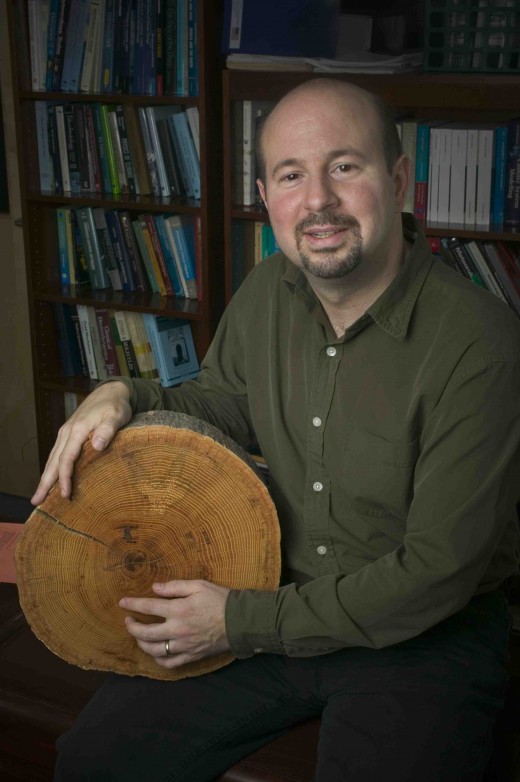
It sounds innocuous enough, something of interest to certain academics—and to no-one else:
…we focused on what we felt was most scientifically interesting, for example that we recovered an unusual pattern for the 1816 “year without a summer” that indicated a very cold Eurasia and lower than average temperatures in North America (observations that are independently confirmed by historical accounts), but a warmer than usual Middle East and Labrador (who knew?). Or that we had independently affirmed anecdotal accounts that there was a whopper of an El Niño event in 1791—a year that, according to our reconstruction, also happened to be a comparative scorcher for Europe and a large part of North America.
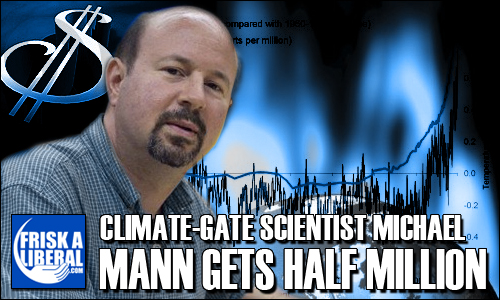
But context is everything. Dr. Mann had just set in motion a train of events that would eventually subject him to accusations, smears, insults, Congressional and State investigations—witch hunts might be a better term—and even death threats.
How could this be? First, the circumstances of publication conspired to give the study a ‘publicity push.’ It came out in Nature, arguably the most prestigious journal of them all, and it happened to come out on Earth Day—April 22, 1998—just when reporters would be looking for a topical story idea. And with another monster El Niño event going on, 1997 and 1998 were both warm years—in fact, record-breakers. With this backdrop, the paper did something else:
..we did the least scientifically interesting thing one could possibly do with these rich spatial patterns: We averaged them to obtain a single number for each year: the Northern Hemisphere average temperature.
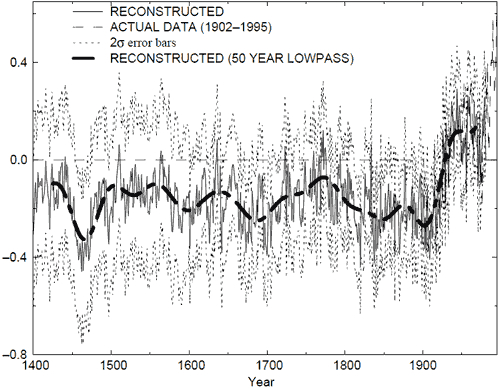
So Global-scale temperature patterns and climate forcing over the past six centuries—as Mann, Bradley and Hughes (1998) was formally titled—enabled news stories to say that current temperatures were not just the warmest of the last 150 years, but of the last 600. Already the issue of climate change was politically sensitive enough that adverse reaction automatically followed a high-profile study suggesting significant human influence on climate.
Sure enough, on June 30 the George Marshall Institute weighed in with the implied suggestion that the paper was written to cater to an extra-scientific agenda:
But why stop at 1400? Because that is just about the farthest back in the recorded past for which this statement is true. Go back just a few hundred years more to the period 1000-1200 A.D. and you find that the climate was considerably warmer than now. This era is known as the Medieval Warm Period.

In fact, the cutoff date of 1400 A.D. reflected the statistical properties of the data.
But soon after MBH (1998), as the paper became known, new work by others extended temperature reconstructions yet further back in time. Mann and colleagues were “a bit skeptical” that the evidence would really support this extension, but “decided it was worth taking a closer look.”
At this point, one of the many ironies of the climate wars comes into play. Sherwood Idso, today known as a climate ‘skeptic,’ had written a 1993 paper with tree-ring scholar Donald Greybill. It showed that fertilization by increased aerial CO2 was detectible in the rings of certain trees in the American West. (Carbon dioxide, as climate-change ‘skeptics’ have pointed out many times since, can indeed be “plant food.”)
But this gave Mann, Bradley and Hughes a research opportunity:
By correcting for that carbon dioxide effect through comparing otherwise similar trends in low- and high-elevation temperature-sensitive North American trees, it seemed we might now be able to make use of the far-longer-term western U.S. data. Indeed, when we used the corrected version of the western U.S. tree ring data in our analysis, our validation tests gave us the green light; we could indeed now meaningfully reconstruct Northern Hemisphere average temperatures over the entire past millennium.
MBH (1999) didn’t make quite the same splash as had its predecessor—at first.
But the graph of the full reconstruction of millenial temperatures would, as it turned out, be prominently featured in the International Panel on Climate Change (IPCC) 2001 Report, the Third Assessment Report, or TAR. It was this graph that became known as the ‘hockey stick.’
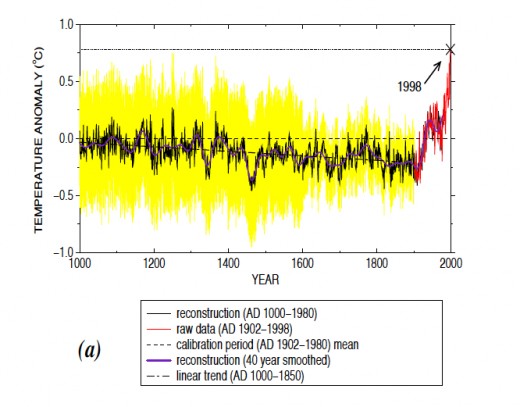
The long, flat 'handle' of the stick—extending back a full thousand years and sloping slightly downward in a cooling trend from the deeper past toward more recent times—balanced with the dramatic upward jut of the 'blade', made a satisfying and even arresting image. The late-twentieth century warming of the global climate was unmistakable; the Medieval Warm Period was reduced to a comparatively unremarkable rise.
By implication, the comforting suggestion that Medieval warmth showed current warming to be nothing to worry about was also (if you will pardon the pun) ‘toast.’
For climate change 'skeptics' determined to resist the emerging scientific picture, this image could not be allowed to stand unchallenged. And so literature began to appear questioning the results of MBH (1999.) Some was scientific—peer-reviewed papers exploring the questions raised. Dr. Mann characterizes this literature as 'part of normal scientific give-and-take.'
HS discusses several in some detail: Pollack et al. (2000), Broecker (2001), Esper et al. (2002), as well as various papers by the original investigators or new colleagues. All contributed toward clarifying the issues of paleoclimate over the past millennium. Even Von Storch et al. (2004)—which became the occasion of some hard feelings when Von Storch himself called the hockey stick graph "nonsense"—sought the common goal of increased understanding.
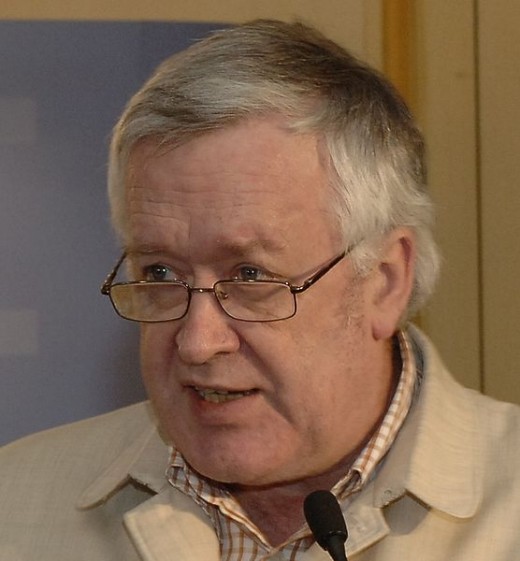
But from the beginning, attacks were also leveled from outside the scientific literature—attacks apparently intended to sow doubt in the public mind. Patrick Michaels—later a colleague of Dr. Mann at the University of Virginia—published two such articles online; these would be followed by criticisms from Dr. Richard Lindzen and Dr. Fred Singer, among others.
The latter two inaugurated what has become a long tradition in contrarian literature, by making significant factual errors in describing the work they sought to contradict. (Lindzen badly mischaracterized the data used, Singer—or more exactly, his invited 'champion,' Wibjorn Karlen—asserted incorrectly that MBH (1999) showed "neither a Medieval Warm Period nor a Little Ice Age." Evidently, for Karlen as for others since, a MWP that did not reach modern levels of warmth was no MWP at all.)
This was just the beginning:
More carefully orchestrated and promoted contrarian attacks were to come. It would become increasingly clear to my colleagues and me that the intent of the attacks was to undermine not just the IPCC, but all of climate science. The attacks would make their way into White House policy and into the floors of the U.S. Senate and House of Representatives. They would become increasingly personal, aimed at singling out specific individuals, me in particular, as if the entire weight of the scientific case for human-caused climate change rested on a handful of scientists.

A notable political salvo was fired on the floor of the US Senate in 2003 by James Inhofe. (It was Inhofe who, in 2005, would famously proclaim climate change to be "the single greatest hoax ever perpetrated on the American public.") Seizing upon a single, deeply flawed study in Energy and Environment by Willie Soon and Sallie Baliunas, he convened a hearing to call into question "the entire science of climate change."
Although the Senate majority was allowed two witnesses and the minority only one—Michael Mann, as it would turn out—the hearing was not a triumph for the ‘skeptics.’ It was dominated by political theater, but the most effective theatre of the hearing turned out to be something of a skeptic ‘own goal.' Minority committee chair Jim Jeffers would create it when he read into the record the startling revelation that fully half of the editorial board of Energy and Environment had just resigned in protest over the 'failed editorial process' which had allowed the publication of such a badly compromised paper. (Those resigning included Hans von Storch.)
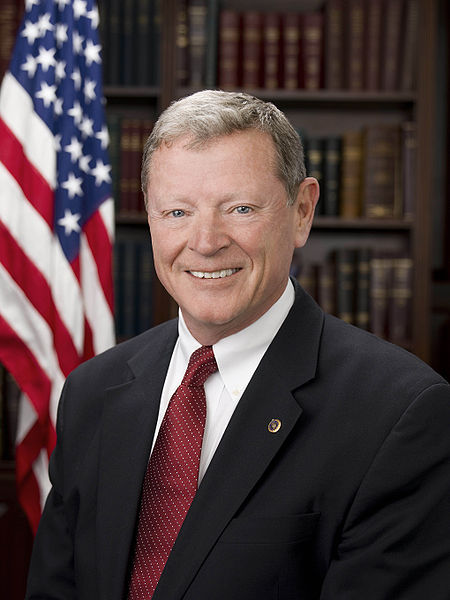
However ineffective this hearing may have been as propaganda, it certainly wasted much scientific time and energy—thereby acting as a deterrent to those foolish enough to speak out on climate change in the future. Yet the main point, Dr. Mann suggests, was neither to chill scientific discourse by intimidating scientists—pure examples of such efforts would come later—nor to sow doubt in the public mind. It was specifically intended as part of a PR and lobbying campaign aimed at ensuring the defeat of the Climate Stewardship Act of 2003.
The apparent campaign included yet another flawed Energy and Environment study, and a USA Today op-ed with false allegations about 'the hockey stick.' (This time the claim was made that the investigators had failed to make their data public; in fact it had long been freely available online. Nonetheless, this idea is still frequently repeated today. This canard's durability is quite strange, given how demonstrably false it is.)
In the event, the Lieberman-McCain Climate Stewardship Act failed, 55-43.
But climate controversy would not fail.
A new analysis by Canadian contrarians Stephen McIntyre (a retired mining executive with a strong mathematical background) and Ross McKitrick (an economist) now purported to show that the hockey stick was an artifact of the statistical method "Principal Component Analysis." (HS gives a good explanation of this method and this issues involved.)
The academic publication of McIntyre and McKitrick (2005) in Geophysical Research Letters was followed, two days later, by a 'David and Goliath' piece in the Wall Street Journal which gave the impression that the hockey stick had been refuted.
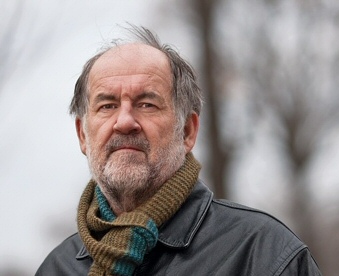
As HS explains in extensive (but happily, lucid) detail, McIntyre and McKitrick had done no such thing. Rather, they:
...applied retention criteria that we had obtained using our convention (modern centering) to [Principal Components] calculated from the tree ring data based on a different convention (long-term centering). Through this error, they eliminated the key hockey stick pattern of long-term variation. In effect, McIntyre and McKitrick had "buried" or "hidden" the hockey stick. They had chosen to throw out a critical pattern in the data as if it were noise, when an objective analysis unambiguously identified it as a significant pattern.
Several peer-reviewed studies confirmed that McIntyre and McKitrick was indeed in error—Waal and Amman (2005), Von Storch and Zorita (2005) and Huybers (2005) were among the first. However, the idea that McIntyre and McKitrick had "broken the hockey stick" persisted—and indeed, continues to persist—in the blogosphere.
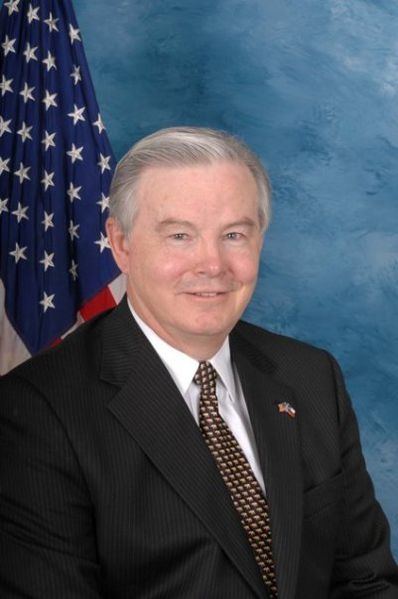
For Dr. Mann, the most consequential sequel of this affair would be another summons from Congress. This time it would come from the House, not the Senate, and the instigator would be Congressman Joe Barton, who infamously would later apologize to BP in the wake of the Deepwater Horizon disaster of 2010. Barton (with Representative Ed Whitfield) demanded that Mann:
List all financial support you have received related to your research, including, but not limited to, all private, state, and federal assistance, grants, contracts (including subgrants or subcontracts), or other financial awards or honoraria... [and] (1) the location of all data archives relating to each published study for which you were an author or co-author, (2) such supporting documentation as computer source code, validation information, and other ancillary information, (3) when this information was available to researchers, (4) where and when you first identified the location of this information, (5) what modifications, if any, you have made to this information since publication of the respective study, and (6) narrative description of the steps... to replicate your study results...
Explain in detail your work for and on behalf of the Intergovernmental Panel on Climate Change... including the process for review of studies and other information, including the dates of key meetings... the steps taken by you, reviewers, and lead authors to ensure the data underlying the studies forming the basis for key findings of the report were sound and accurate... the requests you received for revisions to your written contribution... and... the identity of the people who wrote and reviewed... portions of the report.
Weasel wording in the demand gave the impression that it was backed by the power of Congressional sub poena.

Quite a ‘homework’ assignment—and an ironic one, coming from legislators given to decrying the evils of burdensome governmental oversight. The chilling effect of such demands was evident to scientists the world over—and to editorialists across the US. Barton and Whitfield were soon back-pedalling. As Barton's chief of staff would write:
A few weeks ago, the chairman of the House Energy and Commerce Committee, Rep. Joe Barton, wrote a letter to three honest men and asked for some facts... Fortunately, scientists are almost uniformly proud of their work and downright eager to explain it to the people who pay for it—the taxpayers—and it looks like the three climatologists are no different.

But despite the false bonhomie, Barton was not done. His drive to 'investigate' the hockey stick would result in not one but two Congressional reports in the summer of 2006.
The majority report, carried out by the National Academy of Science, affirmed the validity of MBH's results—though suggesting that, as with most pioneering efforts, some details might be susceptible of better execution.
By contrast, the minority report by statistician Edward Wegman and collaborators recycled McIntyre and McKitrick’s criticisms—some say it 'validates' them—while resolutely ignoring more recent work. The report really added only a 'network analysis' purporting to show that Mann was "at the center" of a "tight-knit cabal of coauthors and peer reviewers."
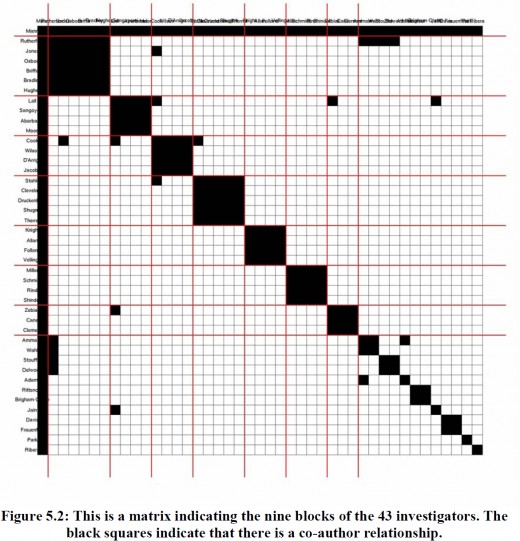
These reports were the focus of new hearings into the hockey stick graph. Once again, the hearings were less than a triumph for the 'investigators,' but once again denialist blogosphere seized the opportunity to declare yet another victory over the hockey stick—and of course to vilify its author.
The Wegman report has fared rather poorly since, as it turns out. Problems with the analysis were spotted by Dr. David Ritson of Stanford even before the hearings ended. Wegman stonewalled all requests for information relating to those aspects of the report—ironically enough, given that he had tried to pillory Mann and colleagues for supposed insufficient openness and transparency.
Skipping ahead to 2009 for a moment, it would be revealed that the report was neither independent nor non-partisan; rather, the panel:
...began with a sounding out by a rabid Republican partisan [Jerry Coffey] and convinced climate 'skeptic.' And Wegman agreed to a process that not only excluded climate scientists, but also involved [Barton staffer] Peter Spencer as a key conduit and gatekeeper providing climate science ducumentation and commentary. And all this was done by a House committee that had refused to even acknowledge the offer of a proper scientific review from the National Academy of Sciences.
—Anonymous blogger 'Deep Climate,' quoted in HS, Note 74, Ch. 15 (p. 363.)
Worse yet, the scholarship of the paper been revealed to rely heavily upon plagiarism:
According to [John] Mashey's estimates, thirty-one of the ninety pages of the [Wegman Report] contained entirely or largely plagiarized material taken from three books and two Wikipedia pages.
—HS, Note 52, Ch. 15, p. 359.
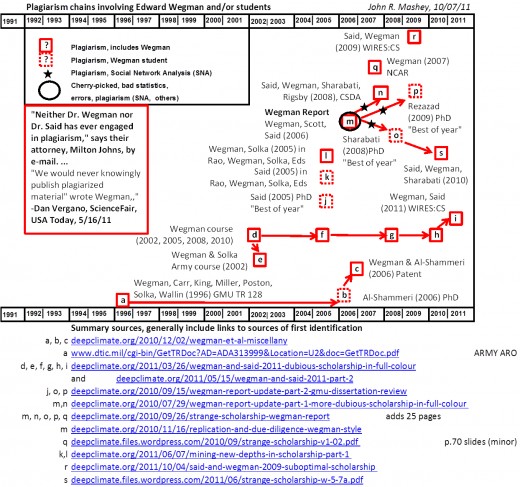
In yet another of the many ironies in the history of climate change politics generally and the Wegman Report specifically, one of the primary targets of the plagiarism was Ray Bradley, the 'B' in 'MBH!' Though not to be trusted in the matter of paleoclimate 'hockey sticks,' he was apparently an indispensible (though unacknowledged) source on the basics of dendrochronology (tree ring studies.)
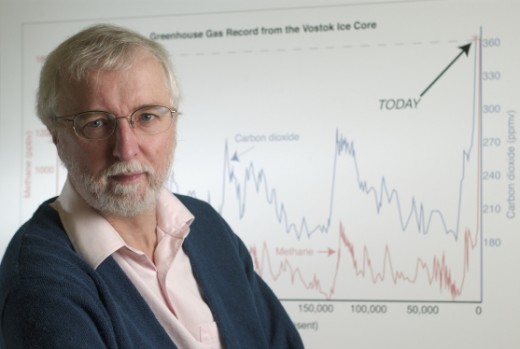
Returning to the aftermath of the duelling hearings of 2006, a period of relative calm ensued.
In fact 2007, by Dr. Mann's account, was "a good time to be a climate scientist." The International Panel on Climate Change released its fourth Assessment Report—generally referred to as AR4—and received "widespread and positive media coverage." This was capped by the award of the Nobel Peace Prize to the IPCC that same year. Mann found this a remarkable, and unexpected, satisfaction.
Summarizing the state of scientific play at that time, HS finds that the four "pillars of defensible climate change skepticism"—that is, distrust of climate models; distrust of the instrumental record of global warming; the existence of other, supposedly contradictory data; and the possibility of other, natural factors being responsible for observed warming—were in a state of "collapse or near collapse."
- When Did Global Warming Stop?
A brief history of global warming cessation--and why it is bogus.
But that did not mean that climate change denialism was done. First, the denialist blogosphere had by now achieved a high level of skill in dealing with ‘inconvenient’ results. It met with few which could not be dealt with by the simple expedients of either ignoring or distorting them.
Second, misleading claims could be 'spun' from legitimate studies or from circumstance—for example, a 2008 study in Nature which showed that long-term greenhouse warming could be masked by natural variability became a claim that 'warming had stopped.' Other writers used the long-standing record warmth of 1998 to claim similarly that 'warming had stopped' in that particular year.
Still others insisted that warming was about to stop, due to weakening Solar activity. In fact, 2009 did prove a relatively cool year by 21st century standards. This provoked yet another spate of claims that decades of warming had been 'wiped out.'
But as we now know with the full clarity of hindsight, global warming would return, just as 'mysteriously', in the record-warm year of 2010.
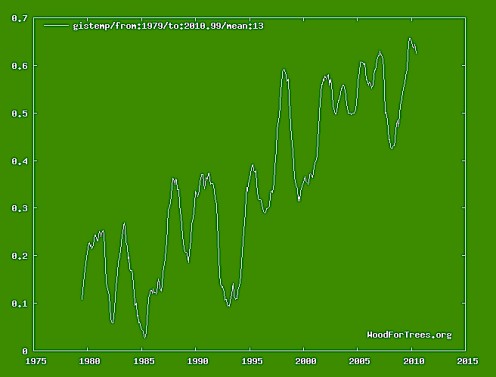
Third, "sciency" efforts to disprove the mainstream continued to come forth. Some were actually peer-reviewed; others appeared in 'pseudo-journals' existing for, or co-opted to, the purpose of affording a platform for "skeptical" views. Several examples are dissected in Chapter 12 of HS.
Dr. Mann summarizes:
It was increasingly unclear that any amount of evidence or additional work would satisfy the critics. After all, the attacks against the hockey stick fundamentally, as we have seen, were not reatlly about the work itself. They were part and parcel of—forgive the pun—a proxy war against the science and its icons being fought by, or at least often funded by, powerful vested interests who found the scientific evidence for climate change inconvenient for political, financial, or philosophical reasons.
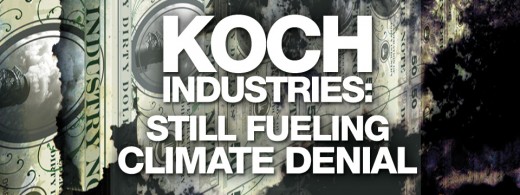
This insight prompted Mann to email colleagues in early 2009 that he was observing:
...a mounting, well organized, and well funded last, attack, a Battle of the Bulge if you will, against the science... Most don't accept the seriousness of the battle we are going to face here.
He was not mistaken. Following a preparatory PR bombardment by think tanks and media spokespersons—often consisting of unsupported allegations of "fraud," "plagiarism" or "scientific misconduct" supposedly committed by those evil climate scientists—the principle attack was launched: the so-called Climategate hack.
D-Day for this battle was November 17, 2009. (The timing was apparently determined by the aim of achieving maximal disruption of the Copenhagen climate change summit, slated for December.)
From many thousands of emails stolen from a vulnerable backup server at the University of East Anglia, hackers had selected a thousand-plus to be included in a downloadable compressed file. Of these, twenty were highlighted with titles, such as "IPCC scenarios not supposed to be realistic."
Whether by collusion or opportunism, the Saudi government was first to call for an investigation, not of the data thieves, but of the climate scientists. The Saudi negotiator, Mohammad Al-Sabban, proved highly active in playing the 'Climategate' card, arguing that "it appears from the details of the scandal that there is no relationship whatsoever between human activities and climate change."
This was not a truth, but it was convenient.
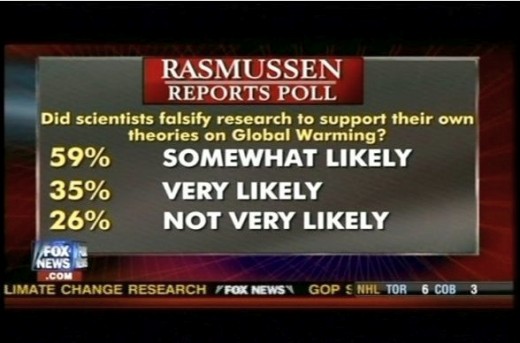
This was just the start of the media firestorm, however. The emails were packaged, disseminated, and publicized with a speed and volume that was to shape the media narrative decisively: in this incident, not just a political candidate but the whole public discourse was 'swiftboated.' One may not admire the integrity of the effort, but it is hard to fault its professionalism.
Catch-phrases originated on denialist websites were rapidly promulgated throughout the entire mediascape by reporters scrambling to keep up with the story: for example, the phrase "smoking gun" was traced from Myron Ebell of the Competitive Enterprise Institute on November 20, via Noel Sheppard of Newsbusters, to Steve Milloy of JunkScience, to the New York Times, Fox News, and CBS News by November 26.
Political and institutional responses were not lacking, either. "Contrarian" politicians quickly raised a hue and cry of 'fraud.' Inhofe issued new demands for investigations, as did Barton. They were joined by such Congressmen as Darrell Issa, Jim Sensenbrenner, and Dana Rohrabacher. Investigations and hearings there would be, both legislative and academic.
But in some ways, this was not the worst:
A campaign of intimidation was meanwhile being waged against climate scientists by influential forces outside the halls of Congress who helped direct hate speech, threats, bullying, and taunting at individual climate scientists. Marc Morano's comment in March 2010 that climate scientists "deserve to be publicly flogged" seemed to set the tone. That was just a few weeks after Fox's Glenn Beck had followed a litany of bogus allegations about the IPCCwith the suggestion that climate scientists commit suicide. Earlier, right-wing provocateur Andrew Breitbart had "tweeted": "Capital punishment for Dr James Hansen Climategate is high treason.”
Harassment Of Climate Scientists
- "Green Fascism": Let The Facts Speak
Activists, researchers and ordinary people expressing their concern about climate change have been called "eco-Nazis" or "green Fascists." Yet it is they who have been vilified, suppressed and threatened.
Numerous scientists received hate mail, threats—and on one memorable occasion, a dead rat delivered to a front doorstep. Some commentator saw more than happenstance, coincidence or popular hysteria at work:
The floods of offensive and threatening emails aimed at intimidating climate scientists have all the signs of an orchestrated campaign by sceptics groups.
(Australian journalist, Clive Hamilton.)
Dr. Mann did not escape this unfortunate distinction, receiving:
...voluminous e-mail and phone messages containing thinly velied threats of harm against me and my family. "You and your colleagues who have promoted this scandal ought to be shot, quartered and fed to the pigs along with your whole damn families," read one e-mail. Another read, "you should know the public will come after you," and "Six feet under, with the roots is were [sic] you should be doin [sic] your magic, how come know [sic] one has [edited] you yet, i was hopin [sic] i would see the news and you commited [sic] suicide."
Official vindications, however, were also not long in coming. Already in March 2010 the House of Commons Science and Technology select committee "verified" the results of the Climate Research Unit, concluding that CRU actions were "in line with common practice." An external review arrived at similar conclusions. On July 1, Penn State found "no substance to the allegation against Dr. Michael E. Mann;" this would be followed by the National Science Foundation Office of the Inspector General finding "no research misconduct or other matter raised..."
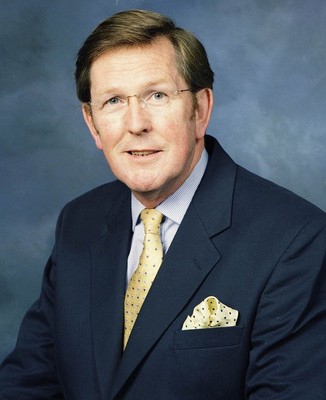
The final CRU investigation results were released in early July as well. Commissioned by the University of East Anglia and led by Sir Muir Russell, this "unusually thorough, well-documented 160-page report" found:
...no evidence of scientific wrongdoing on the part of any scientists who had been tarred with various climategate allegations. Refuting the claim that CRU had somehow rigged its global temperature estimates or deleted critical data, the committee went through the rather extraordinary measure of reproducing the global temperature record from scratch, using publically archived data and methods.
(This would be the same data and methods so often claimed to have been 'withheld' from the public.)
But cries of "whitewash" were predictable and immediate—the Wall Street Journal was one prominent outlet to issue them—and like less prestigious papers, it did so without any support other than prejudice. Apparently Virginia State Attorney General Ken Cuccinelli took such allegations seriously:
He demanded that the University of Virginia turn over essentially every e-mail, record, or document it had that related to [Dr. Mann] from [his] time there from 1999 to 2005. Cuccinelli used a relatively new legal maneuver available to the attorney general known as a civil investigative demand (CID). With a CID, the attorney general could seek to subpoena materials from any state agency, including a university, by claiming that fraud concerning state funds might be involved.
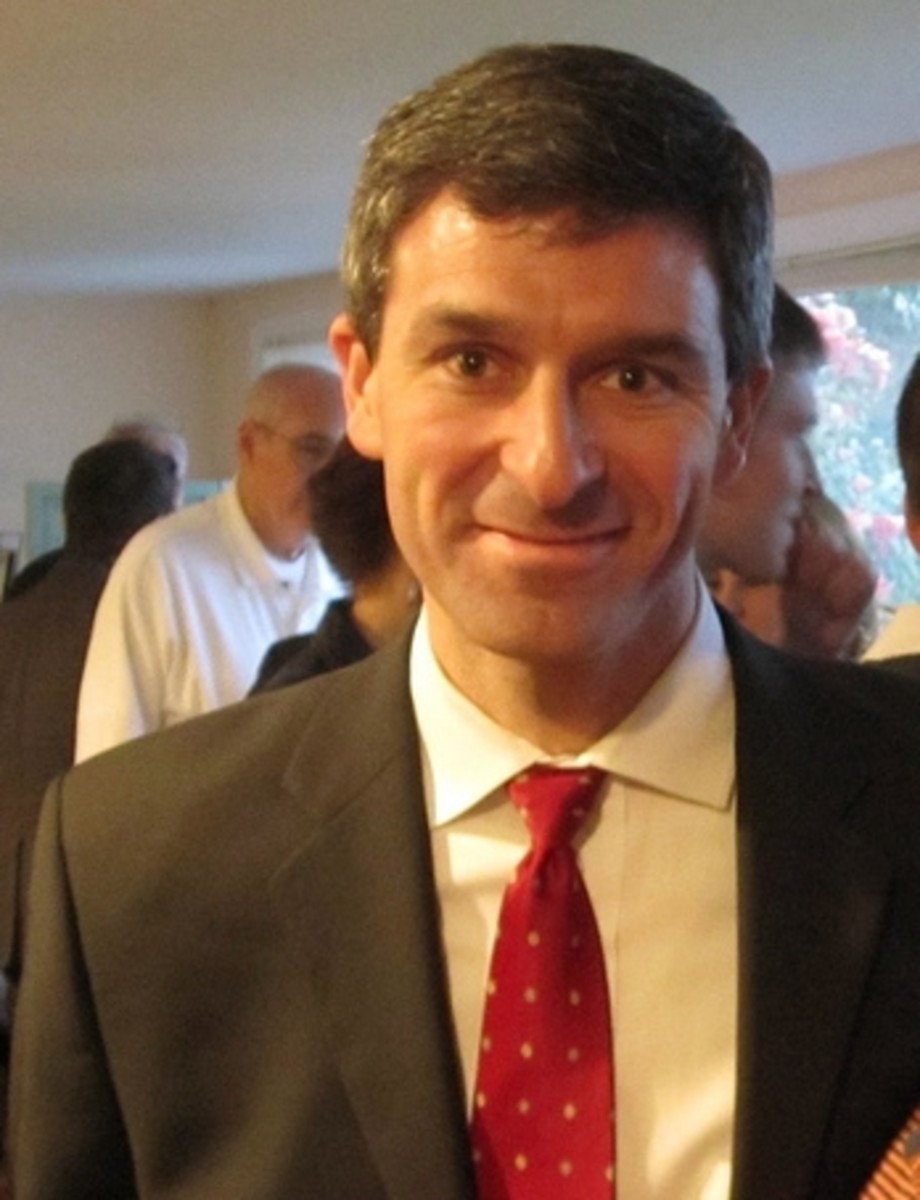
This investigation—discussed at more length in the "Green Fascism" Hub, linked above—would last two years before culminating in ignominious dismissal by the Supreme Court of Virginia, though not before reportedly costing the University of Virginia more than $600,000. It was widely decried as an abuse of prosecutorial power, a waste of taxpayer money, and a threat to academic freedom.
The result was a powerful backlash: the Union of Concerned Scientists, Nature, the American Meteorological Society and the American Association for the Advancement of Science denounced Cuccinelli's tactics, as did 900 Virginia academics who petitioned for its withdrawal. Most dramatically, perhaps, 250 members of the National Academy of Sciences (including 11 Nobel laureates) published an open letter in Science:
We... call for an end to McCarthy-like threats of criminal prosecution against our colleagues based on innuendo and guilt by association, the harassment of scientists by politicians seeking distraction to avoid taking action, and the outright lies being spread about them. Society has two choices: We can ignore the science and hide our heads in the sand and hope we are lucky, or we can act in the public interest to reduce the threat of global climate change quickly and substantively.
In Dr. Mann's words, the tactics of the Cuccinellis, Bartons and Inhofes had "awakened a sleeping bear."
Today—and sad to say—those tactics continue. But The Hockey Stick And The Climate Wars is, in a way, a testament to their counterproductive nature. After all, the narrative sketched repeatedly gives us examples of denialist over-reach begetting revulsion and rejection. But a deeper example is the narrative of Dr. Mann's personal journey, which I’ve largely ignored so far.
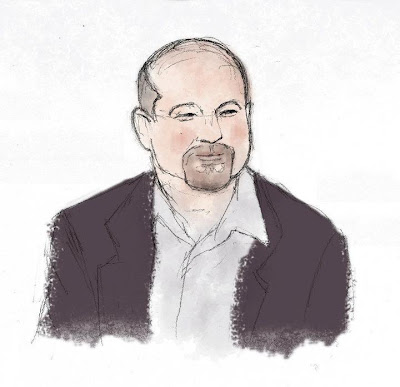
Beginning as a "curiosity-driven" researcher in condensed-matter physics, he took a "random scientific walk" into climate research during his Doctoral program. But things were different in the mid-90s:
When I first began to work with my Ph.D. adviser Barry Saltzman in the early 1990s, he, like many other climate researchers at the time, remained unconvinced that there was yet a detectable human influence on the climate... other scientists, such as NASA's James Hansen and Stanford University's Stephen Schneider, were convinced by the evidence already in hand that human-caused climate change was indeed now upon us. I myself was closer to Barry's position than to Hansens's or Schneider's. In particular, I felt that natural climate variability might be more important than some scientists thought. Indeed, it was that very assumption that motivated my Ph.D. research topic.
This interest in natural variability led to an irony: one of Mann’s first papers, a collaboration with Jeffrey Park, provided evidence for the existence of a natural cycle, the Atlantic Multidecadal Oscillation, or AMO. It has served contrarians as “a favorite catch-all explanation for just about any observed climate trend.” One wonders if any of them are aware that the term itself was coined by that ‘warmist’ arch-fiend, Michael Mann.
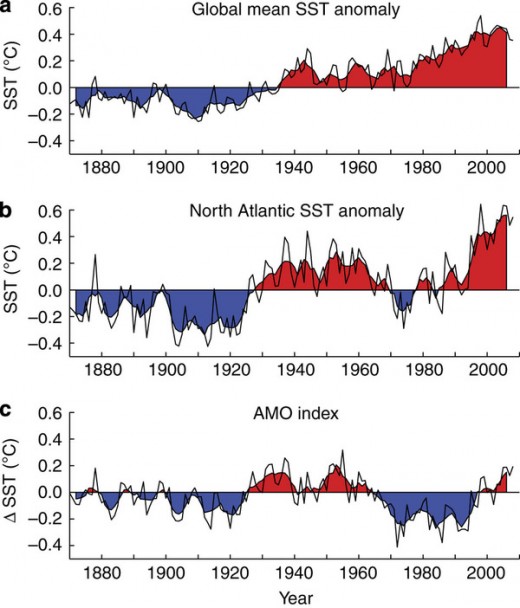
As noted above, however, the evidence for the human role in observed warming, like the evidence for that warming itself, just kept getting stronger. Mann, like thousands of other scientists weighing that evidence as the new millennium progressed, could not be unaffected. But I suspect that there was another factor at work, for Dr. Mann as for other researchers.
Denialist disregard for truth, fairness, and even basic logic, might not validate (or invalidate) the science. Certainly, the tactics employed suggested that truth was not on their side—else they would presumably rely more upon rational argument, and less on PR or political bullying—but of course tactics cannot not ‘prove’ anything from a scientific perspective. One can in principle 'fight dirty,' yet be correct.
Yet the denialist campaign implicitly validated the topic of climate change. Think-tanks, public relations firms, 'friendly' media and paid 'experts' would hardly be bankrolled to the tune of many tens of millions of dollars to smear scientists and distort their results over unimportant trivialities.
And even such a back-handed validation has its effect on those affected by it. Like other humans, scientists tend to want their work to matter—to be of significance to wider human society, as well as to the immediate scientific community.
Mann certainly felt this way. He wrote of the period toward the end of his initial program of Doctoral study:
I was being steered toward increasingly applied areas of research… This wasn’t quite the “big-picture” science I’d had in mind when I decided to go into physics in the first place. I was somewhat disillusioned and felt as if I’d lost my bearings. Facing a vocational crisis, I opened up the university catalog one day to see what other scientific research was being done at Yale where I might be able to apply my math and physics interests to working on a big-picture problem of significance.
As I scrolled through the catalog, I discovered that a professor in the Department of Geology and Geophysics, Barry Saltzman, was using the tools of physics to simulate Earth’s climate. That sounded like a big-picture problem to me, and an important one at that.
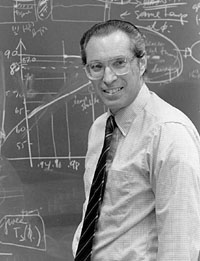
So the vociferous denunciations, the smears, the bullying—all served as eloquent testimony that climate science, whatever else might be said, mattered intensely. The evidence convinced Mann on the role of humans in climate change, but the denialist reaction convinced him of its relevance to human life.
In a real sense, the denialists have created the very scientific activism that they so often decry:
Meanwhile, climate change contrarians continue to launch hand grenades, the denial machine persist in churning out disinformation, and the attacks against climate scientists—myself included—continue. Yet something is different now. The forces of climate change denial have, I believe, awakened a “sleeping bear.” My fellow scientists will be fighting back, and I look forward to joining them in this battle.
This change in Mann’s orientation is a powerful narrative thread in HS. Though his “walk” into climate science may have (as he says) a “random” beginning, it has become highly purposeful. He is convinced that the evidence points to socially-important consequences, and is fully committed to helping to educate society on the choices facing us all.
But there is more than the just the understandable desire by a workman to do good work and to benefit society, powerful though that motivation can be. Dr. Mann’s personal life is largely ‘off-screen’ in HS. But he does mention that part of his personal journey was marriage and fatherhood.
And famously, parenthood—even ‘frivolous’ parts, such as the humble family vacation—changes everything:
My daughter was entranced by the Keys—the mangrove forests, the sonorous birds, the leaping dolphins, the coral reefs with their exotic and colorful fish...
I am determined to do whatever I can to make sure that it will be possible for us to return decades from now—my wife and me, our daughter, her children, and perhaps theirs—to again marvel at these natural wonders. While slowly slipping away, that future is still within the realm of possibility. It is a matter of what path we choose to follow.

Other Hubs by Doc Snow
- Global Warming Science, Press, And Storms: Nils Ekholm
Scientists are expected to live and die on the quality and integrity of their data analysis—but usually that is a metaphor. Not for Nils Ekholm! Read the story of this remarkable scientist, self-made man and sometime Arctic explorer! - Strange Days Again: Remembrance And The Doors' Sophomore Album
Music and memory intertwine: The Doors' most innovative album, "Strange Days," analyzed and remembered. What it was, is, and why it mattered so much to me. - "Responsibility," or "Driver, Boy and Girl"
A short story about responsibility, school buses, history, and burnings big and small. . . "Afternoon on a warm spring day in central Ontario, with a school bus dragging a dust plume up and down the county roads..." - Global Warming Science In The Age Of Washington And Jefferson: William Charles Wells
Some argue that greenhouse warming is thermodynamically impossible. But observations and experiments going back as much as 350 years tell a different story. Among the first to study radiation in the atmosphere was an unassuming doctor... - Two Losses In Second Person
"Two Losses" consists of a pair of autobiographical poems, "Elegy," and "Breaking Up Is Hard To Do." Terse and unsentimental, the poems 'tell it as it was.'


